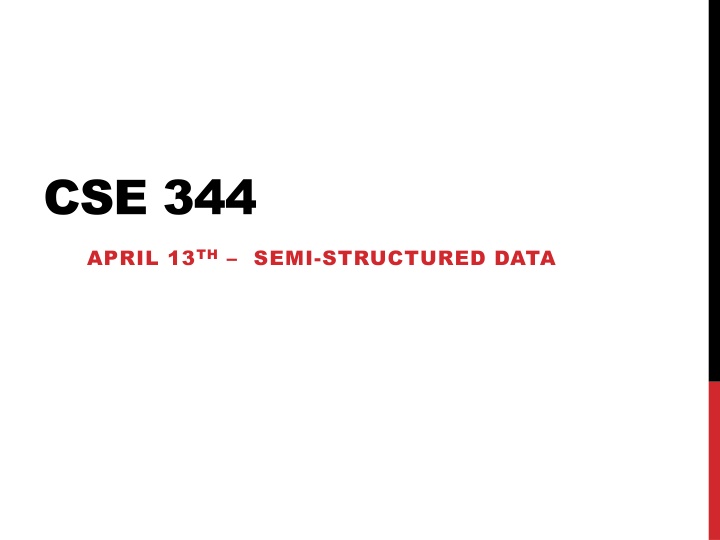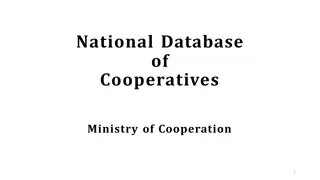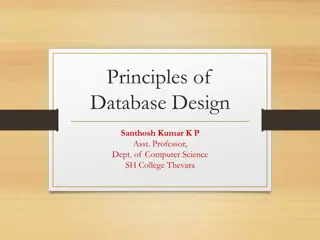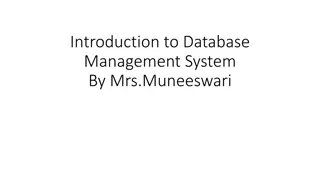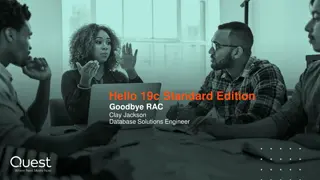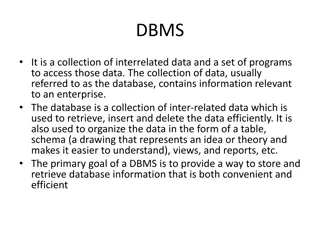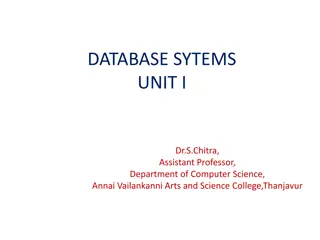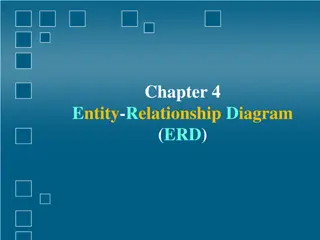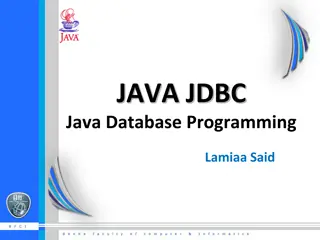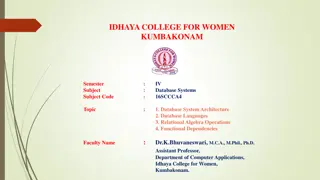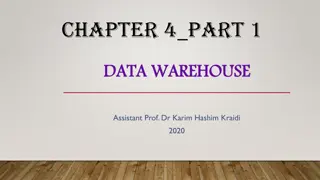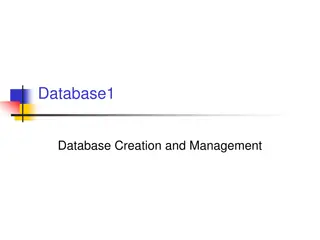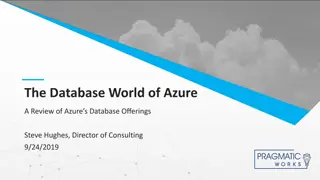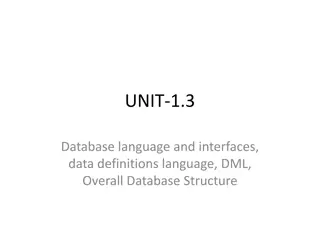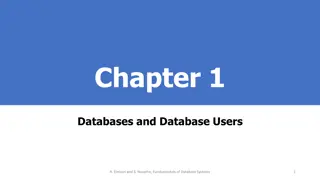Database Systems Overview
Fundamentals of database systems, covering topics such as relational data models, query languages, NoSQL databases, RDBMS internals, parallel query processing, transactions, and more. Understand the two classes of database applications, OLTP and OLAP, along with the motivation behind NoSQL solutions. Delve into challenges faced by single-server DBMS and the concept of scaling out to multiple servers. Review serverless and client-server models in RDBMS setups."
Uploaded on Mar 03, 2025 | 0 Views
Download Presentation

Please find below an Image/Link to download the presentation.
The content on the website is provided AS IS for your information and personal use only. It may not be sold, licensed, or shared on other websites without obtaining consent from the author.If you encounter any issues during the download, it is possible that the publisher has removed the file from their server.
You are allowed to download the files provided on this website for personal or commercial use, subject to the condition that they are used lawfully. All files are the property of their respective owners.
The content on the website is provided AS IS for your information and personal use only. It may not be sold, licensed, or shared on other websites without obtaining consent from the author.
E N D
Presentation Transcript
CSE 344 APRIL 13TH SEMI-STRUCTURED DATA
ADMINISTRATIVE MINUTIAE HW3 due Wednesday Pull new upstream- correct schema OQ4 due Wednesday HW4 out Wednesday (Datalog) Midterm Exam Wednesday, May 9th
CLASS OVERVIEW Unit 1: Intro Unit 2: Relational Data Models and Query Languages Unit 3: Non-relational data NoSQL Json SQL++ Unit 4: RDMBS internals and query optimization Unit 5: Parallel query processing Unit 6: DBMS usability, conceptual design Unit 7: Transactions Unit 8: Advanced topics (time permitting)
TWO CLASSES OF DATABASE APPLICATIONS OLTP (Online Transaction Processing) Queries are simple lookups: 0 or 1 join E.g., find customer by ID and their orders Many updates. E.g., insert order, update payment Consistency is critical: transactions (more later) OLAP (Online Analytical Processing) aka Decision Support Queries have many joins, and group-by s E.g., sum revenues by store, product, clerk, date No updates
NOSQL MOTIVATION Originally motivated by Web 2.0 applications E.g. Facebook, Amazon, Instagram, etc Web startups need to scaleup from 10 to 100000 users very quickly Needed: very large scale OLTP workloads Give up on consistency Give up OLAP
WHAT IS THE PROBLEM? Single server DBMS are too small for Web data Solution: scale out to multiple servers This is hard for the entire functionality of DMBS NoSQL: reduce functionality for easier scale up Simpler data model Very restricted updates
RDBMS REVIEW: SERVERLESS Desktop User SQLite: One data file One user One DBMS application DBMS Application (SQLite) Consistency is easy But only a limited number of scenarios work with such model File Data file Disk
RDBMS REVIEW: CLIENT-SERVER Client Server Machine Applications File 1 Connection (JDBC, ODBC) File 2 File 3 DB Server One server running the database Many clients, connecting via the ODBC or JDBC (Java Database Connectivity) protocol
RDBMS REVIEW: CLIENT-SERVER Many users and apps Consistency is harder transactions Client Server Machine Applications File 1 Connection (JDBC, ODBC) File 2 File 3 DB Server One server running the database Many clients, connecting via the ODBC or JDBC (Java Database Connectivity) protocol
CLIENT-SERVER One server that runs the DBMS (or RDBMS): Your own desktop, or Some beefy system, or A cloud service (SQL Azure)
CLIENT-SERVER One server that runs the DBMS (or RDBMS): Your own desktop, or Some beefy system, or A cloud service (SQL Azure) Many clients run apps and connect to DBMS Microsoft s Management Studio (for SQL Server), or psql (for postgres) Some Java program (HW8) or some C++ program
CLIENT-SERVER One server that runs the DBMS (or RDBMS): Your own desktop, or Some beefy system, or A cloud service (SQL Azure) Many clients run apps and connect to DBMS Microsoft s Management Studio (for SQL Server), or psql (for postgres) Some Java program (HW8) or some C++ program Clients talk to server using JDBC/ODBC protocol
WEB APPS: 3 TIER Browser File 1 File 2 File 3 DB Server
WEB APPS: 3 TIER Browser File 1 Connection (e.g., JDBC) File 2 HTTP/SSL File 3 DB Server App+Web Server
WEB APPS: 3 TIER Browser Web-based applications File 1 Connection (e.g., JDBC) File 2 HTTP/SSL File 3 DB Server App+Web Server
WEB APPS: 3 TIER Web-based applications File 1 App+Web Server Connection (e.g., JDBC) File 2 HTTP/SSL App+Web Server File 3 DB Server App+Web Server
Replicate App server for scaleup WEB APPS: 3 TIER Web-based applications File 1 App+Web Server Connection (e.g., JDBC) File 2 HTTP/SSL App+Web Server File 3 DB Server Why not replicate DB server? App+Web Server
Replicate App server for scaleup WEB APPS: 3 TIER Web-based applications File 1 App+Web Server Connection (e.g., JDBC) File 2 HTTP/SSL App+Web Server File 3 DB Server Why not replicate DB server? Consistency! App+Web Server
REPLICATING THE DATABASE Two basic approaches: Scale up through partitioning Scale up through replication Consistency is much harder to enforce
SCALE THROUGH PARTITIONING Partition the database across many machines in a cluster Database now fits in main memory Queries spread across these machines Can increase throughput Easy for writes but reads become expensive! Application updates here May also update here Three partitions
SCALE THROUGH REPLICATION Create multiple copies of each database partition Spread queries across these replicas Can increase throughput and lower latency Can also improve fault-tolerance Easy for reads but writes become expensive! App 1 updates here only App 2 updates here only Three replicas
RELATIONAL MODEL NOSQL Relational DB: difficult to replicate/partition Given Supplier(sno, ),Part(pno, ),Supply(sno,pno) Partition: we may be forced to join across servers Replication: local copy has inconsistent versions Consistency is hard in both cases (why?) NoSQL: simplified data model Given up on functionality Application must now handle joins and consistency
DATA MODELS Taxonomy based on data models: Key-value stores e.g., Project Voldemort, Memcached Document stores e.g., SimpleDB, CouchDB, MongoDB Extensible Record Stores e.g., HBase, Cassandra, PNUTS
KEY-VALUE STORES FEATURES Data model: (key,value) pairs Key = string/integer, unique for the entire data Value = can be anything (very complex object)
KEY-VALUE STORES FEATURES Data model: (key,value) pairs Key = string/integer, unique for the entire data Value = can be anything (very complex object) Operations get(key), put(key,value) Operations on value not supported
KEY-VALUE STORES FEATURES Data model: (key,value) pairs Key = string/integer, unique for the entire data Value = can be anything (very complex object) Operations get(key), put(key,value) Operations on value not supported Distribution / Partitioning w/ hash function No replication: key k is stored at server h(k) 3-way replication: key k stored at h1(k),h2(k),h3(k)
KEY-VALUE STORES FEATURES Data model: (key,value) pairs Key = string/integer, unique for the entire data Value = can be anything (very complex object) Operations get(key), put(key,value) Operations on value not supported Distribution / Partitioning w/ hash function No replication: key k is stored at server h(k) 3-way replication: key k stored at h1(k),h2(k),h3(k) How does get(k) work? How does put(k,v) work?
Flights(fid, date, carrier, flight_num, origin, dest, ...) Carriers(cid, name) EXAMPLE How would you represent the Flights data as key, value pairs? How does query processing work?
Flights(fid, date, carrier, flight_num, origin, dest, ...) Carriers(cid, name) EXAMPLE How would you represent the Flights data as key, value pairs? Option 1: key=fid, value=entire flight record How does query processing work?
Flights(fid, date, carrier, flight_num, origin, dest, ...) Carriers(cid, name) EXAMPLE How would you represent the Flights data as key, value pairs? Option 1: key=fid, value=entire flight record Option 2: key=date, value=all flights that day How does query processing work?
Flights(fid, date, carrier, flight_num, origin, dest, ...) Carriers(cid, name) EXAMPLE How would you represent the Flights data as key, value pairs? Option 1: key=fid, value=entire flight record Option 2: key=date, value=all flights that day Option 3: key=(origin,dest), value=all flights between How does query processing work?
KEY-VALUE STORES INTERNALS Partitioning: Use a hash function h, and store every (key,value) pair on server h(key) In class: discuss get(key), and put(key,value) Replication: Store each key on (say) three servers On update, propagate change to the other servers; eventual consistency Issue: when an app reads one replica, it may be stale Usually: combine partitioning+replication
DATA MODELS Taxonomy based on data models: Key-value stores e.g., Project Voldemort, Memcached Document stores e.g., SimpleDB, CouchDB, MongoDB Extensible Record Stores e.g., HBase, Cassandra, PNUTS
MOTIVATION In Key, Value stores, the Value is often a very complex object Key = 2010/7/1 , Value = [all flights that date] Better: allow DBMS to understand the value Represent value as a JSON (or XML...) document [all flights on that date] = a JSON file May search for all flights on a given date
DOCUMENT STORES FEATURES Data model: (key,document) pairs Key = string/integer, unique for the entire data Document = JSon, or XML Operations Get/put document by key Query language over JSon Distribution / Partitioning Entire documents, as for key/value pairs We will discuss JSon
DATA MODELS Taxonomy based on data models: Key-value stores e.g., Project Voldemort, Memcached Document stores e.g., SimpleDB, CouchDB, MongoDB Extensible Record Stores e.g., HBase, Cassandra, PNUTS
EXTENSIBLE RECORD STORES Based on Google s BigTable Data model is rows and columns Scalability by splitting rows and columns over nodes Rows partitioned through sharding on primary key Columns of a table are distributed over multiple nodes by using column groups HBase is an open source implementation of BigTable
WHERE WE ARE So far we have studied the relational data model Data is stored in tables(=relations) Queries are expressions in SQL, relational algebra, or Datalog Next week: Semistructured data model Popular formats today: XML, JSon, protobuf
